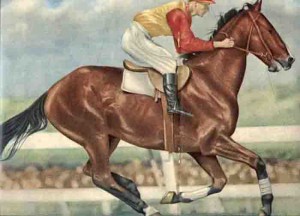Great Clashes of the Past
By Harley Walden
THE Australian and New Zealand turf is studded with memorable and heroic clashes between champions, yet there is one that stands alone and 82,000 people who were at Randwick on September 30, 1922, would vouch for that.
The horses were Gloaming, of Christchurch, and Beauford of Newcastle.
They met four times in 25 days at weight-for-age in Sydney and the score was two each.
Testimony to their greatness and the excitement of their tussles in that spring of 1922 at Randwick and Rosehill is found everywhere closing in of nearly a century later both in Sydney and no doubt New Zealand, too.
Looking down on patrons at the top of the Members’ Stand escalators in the Canterbury track are framed pictures of the finish of two of their races—the Spring Stakes and the Craven Plate at Randwick.
Agitated jockeys probably never notice and stewards are usually too busy to look at the pictures on the wall, but the stipes inner-sanctum at Randwick is adorned with poses pictures of two plain looking geldings, Beauford and Gloaming.
The two old champs seem to stare down on everyone and everything, including the video equipment which did not exist in their day.
What makes this pair the pick in the history of Australian racing?
What makes them so mighty and how did they attract 82,000 to Randwick for their decider in the weight-for-age Spring Stakes (12 furlongs) on September 30, 1922, when the Australian population was five million?
There is a heap of candidates for the best of the great clashes in major weight-for-age classic and handicap events in New Zealand.
Not the least of them the Bonecrusher and Our Waverley Star, the two New Zealand geldings who fought it out head to head, shoulder to shoulder, with whips cracking in the $750,000 W S Cox Plate over 2040m at Moonee Valley on October 25, 1986.
The public did not seem to mind that this an all-New Zealand finish, that the two geldings from across the Tasman annihilated the Aussie opposition, and that in fact the third horse, the Filbert, was also a New Zealander.
Who could ever forget the finish of the 1956 Melbourne Cup, as Bart Cumming’s two champions Light Fingers and Ziema went to the line locked together and the Prince of race-callers the late Ken Howard declaring a dead-heat, and then! “No I’ll give it to Light Fingers”.
That one was one of the many in a list of hundreds with New Zealand horses, jockeys and trainers playing a major role, from the days of Carbine in 1888 when he was a three-year-old, over from the Dominion to take on Australia’s best.
Phar Lap did not engage in any notable clashes for the good reason that he was in a class of his own and the same applied to Tulloch when he was at his peak as a super three-year-old. And it was a pity that Bernborough never met Shannon.
Kingston Town’s amazing finish to win his third W S Cox Plate in 1982 put him in the history books forever, yet the King did not have many great weight-for-age struggles as he was usually too good for his opposition.
The modern generation will remember the enthralling bouts between the big grey mare Emancipation and the compact bay three-year-old colt Sir Dapper in the Sydney autumn of 1984.
They stated off in the Expressway Stakes (1200m) at Randwick on February 11.
Sir Dapper (Mick Dittman) was first by 1-3/4 lengths from Emancipation (Ron Quinton).
Emancipation finished the race with blood oozing from a wound on her hind leg.
She had an excuse.
The stage was therefore set for round two in the George Ryder Stakes over 1400m at Rosehill on April 7.
This time, Emancipation (Quinton) led all the way to beat Sir Dapper who was pocketed, Dittman having no room fore or aft as the wily Quinton held Sir Dapper in.
Sir Dapper started favourite for their third clash in the All Aged Stakes (1600m) at Randwick on April 22.
Emancipation led all the way, holding Sir Dapper’s challenge, but the courageous colt was badly stripped in the run, blood pouring from a sickening-looking hole in his hind leg.
Emancipation had won the three round contest 2-1 and the two Sydney horses had outclassed their rivals.
Sir Dapper did not get his chance for revenge as his trainer Les Bridge and owners – Mr and Mrs Peter Horwitz, Mr and Mrs Morrie Macleod, Mike Willesee and Robbie Porter—retired him immediately to the Trans Media Stud at Cootamundra.
Many of these clashes are fresh in our minds, but the real big start came with the meeting of Cruciform, a New Zealander, and Wakeful, a Victorian, in 1903.
Mr G G Stead set the ball rolling by practically challenging Mr Leslie Macdonald of Melbourne to pit Wakeful, the champion of Australia, in the Spring Stakes against Cruciform the champion of New Zealand.
Mr Stead bought his famous mare across the Tasman and the newspapers did the rest.
This distinguished pair duly met in the Spring Stakes and they were received by a crowd which old hands declared doubled the biggest ever previously seen at Ranwick.
Cruciform (Les Hewitt) beat Wakeful (F Dunn) by a head after a dour head-to-head struggle over the Randwick 1½ miles. Wakeful was trained in Melbourne by Hugh Munro, the father of the champion jockeys Darby and Jim. Cruciform was trained by Dick Mason who was to return with Gloaming.
If half of what one read in the Melbourne papers was correct, it was fair to assume that double as many people went to Flemington as to Randwick.
The day Carbine beat Abercorn in the Champion Stakes there were certainly double as many at Flemington s at Randwick a month later when Abercorn downed Carbine in the Autumn Stakes.
But the sporting enterprise of Messrs Stead (owner of Cruciform) and Macdonald (owner of Wakeful) transformed comparative sympathy into keen interest and, people have since enriched racecourse proprietors beyond the dreams of avarice.
These great clashes virtually founded racings’ appeal to the public.
It was of course to become the nation’s number one spectator sport until the birth of the TAB which has encourage the masses to bet but not attend the track.
If Carbine, Abercorn, Wakeful and Cruciform were the first to draw the crowds after the construction of grandstands, then there were memorable contests to follow.
The stands got bigger.
Some of these horses are legends, not merely by virtue of the history books of the turf, but by pub and club differences of opinion.
Shannon never clashed with Bernborough, one of the great contests that never came off.
Kindergarten had one run here, failed and went back to New Zealand where he remains a legend.
And yes Todman did beat Tulloch in the Champagne Stakes in the second of their meetings, Tulloch won the other (conclusively) in in the Sires’ Produce Stakes of 1957 at Randwick.
Gunsynd and Tails revived memories of the greats of the past at Randwick on April 4, 1972, when they had a ding-dong battle down the straight in the Queen Elizabeth Stakes over 1 ¾ miles.
Tails (Sammy Howard) beat Gunsynd (Roy Higgins) by ¾ of a length.
This was one of the best races of the modern era, two personality horses of character and fighting spirit going stride for stride and the crowd roared its approval for Tails even though Gunsynd was the hot favourite.
Chatham, Rogilla and Winooka—three of the greatest horses ever to grace Randwick—ran first, second and third in that order in the 1932 Epsom after Rogilla and Chatham had dear-heated in the Tramway Hcp leading up to the Epsom.
They were almost certainly the top three as a group ever to fill the placings in a major Group one handicap over a mile at Randwick.
Gunsynd, Tails, Comic Court, Emancipation, Sir Dapper, Chatham, Peter Pan, Rogilla, Carbine, Abercorn, Wakeful and all the others included could not match the sustained excitement of the four Beauford-Gloaming bouts of 1922.
This is how they finished—Chelmsford Stakes Sept 9, 1922 won by Beauford, the Hill Stakes Sept 16, 1922 won by Gloaming, the Spring Stakes Sept 30, 1922 won by Beauford, the Craven Plate Oct 4, 1922 won Gloaming.
The cold results cannot tell the story.
The score was one-all going into their third meeting in the Spring Stakes which Beauford won by a neck after the two geldings singled out head to head over the last furlong before an 82,000 crowd at Randwick on Derby Day.
The Craven Plate, their fourth clash, was no anti-climax.
Maybe it was a record for a Wednesday meeting at Randwick on October 4, 1922, when an estimated 50,000 watched them do battle with Gloaming strolling away to an easy three-length win on a wet, windy day.
The reports were that Beauford was weary and wouldn’t eat and that is why Gloaming started favourite at even money.
Beauford was a big, gangly gelding bred by his owner W H Mackay and trained at Newcastle by Sid Killick.
The Newcastle-Maitland and Hunter districts has always been proud of its sporting champions—Les Darcy, Jim Pike, Stan Davidson, Wayne Harris, Beauford, Rogilla, Luskin Star and Dave Sands for example.
Darcy was fresh in the memories when the Coalfields fraternity had another hero—Beauford.
W H Mackay bred him at his property Albano, near Maitland. The big fellow was by the imported Beau Boult from Blueford.
Bert Griffith, a resident of Scone (grand-father of Mudgee based trainer Mack and Luke Griffith of Scone) whose father Bob worked for W H Mackay for 40 years, said Beauford was big and nervous, a horse who hated noise.
Recalling his father’s recollections of the horse Bert Griffith once said: “Long after his retirement Beauford bolted and took to the bush. Dad couldn’t find him for a week or so.”
“He had swum the Hunter River, then gone to the top of the range near Mr Mackay’s property. The horse was content to be out there on his own. He was a loner, highly strung, a one-man horse. He used to go off his tucker and everyone use to say that Gloaming would never had beaten him only for that. Beauford was eventually put down by Bob Griffiths at the Mackay property Anambah outside Maitland on the banks of the Hunter River.”
Gloaming was bred in Victoria by Earnest Clark who sold him to G D Greenwood of Christchurch, NZ, as a yearling for 230 guineas.
Gloaming eventually won 57 races from 67 starts.
The only time he did not finish first or second was the day he fell in a race at Trentham.
If he was not the greatest gelding ever to grace the Australasian turf then there have been few better.
Racing’s history will be further enriched in the years to come if we can produce another Beauford or a Gloaming.
 scone.com.au
scone.com.au
